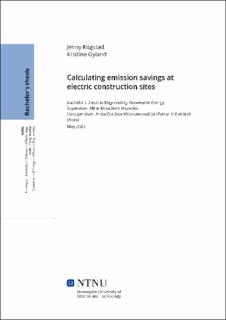| dc.contributor.advisor | Hazarika, Mihir Mouchum | |
| dc.contributor.author | Kogstad, Jenny | |
| dc.contributor.author | Gyland, Kristine | |
| dc.date.accessioned | 2023-07-12T17:21:58Z | |
| dc.date.available | 2023-07-12T17:21:58Z | |
| dc.date.issued | 2023 | |
| dc.identifier | no.ntnu:inspera:142213037:147032193 | |
| dc.identifier.uri | https://hdl.handle.net/11250/3078472 | |
| dc.description.abstract | Norge har satt seg et mål om å ha en utslippsfri byggebransje innen 2030. For at dette skal være mulig er det nødvendig å finne en alternativ energikilde for å drifte byggeplassene. Aneo Build har en løsning der de leverer mobile batterikontainere som åpner muligheten for hel-elektriske byggeplasser. Fokuset for denne oppgaven var å utvikle de beregningene Aneo har gjort på utslippsbesparelser for en elektrisk byggeplass sammelignet med en byggeplass som er driftet på diesel.
For å utvikle beregningene ble det tatt med utslipp fra produksjonen av diesel, dieselmotoren og batteriene brukt i ladekontainerene. For å finne disse utlippenene ble det hentet inn data fra tre livsløpsanalyser. For å regne ut utslippsbesparelsene fra driftfasen ble tall oppgitt av Aneo brukt, i tillegg ble noen tall oppdatert. Beregningene for utslippsbesparelsene ble gjort i en Excelmodell. Hensikten bak denne modellen er at Aneo skal bruke den til å gjøre beregninger for kommende prosjekter og prosjekter som er ferdig. Resultatene er presentert på en forståelig måte slik at Aneo kan vise modellen for kunder.
Det ble brukt et av Aneo sine tidligere prosjekt for å presentere resultatene fra modellen. For dette prosjektet viste det seg at prosjektet hadde høye utslippsbesparelser i driftfasen, men at hvis produksjonen ble inkludert i beregningene ville ikke prosjektet ha noe besparelser. Tilsvarende prosjekt måtte utføres omtrent 1,5 ganger for å få noen utslippsesparelser. Dette kommer av at produksjonen av batterier har høyere utslipp enn produksjonen av diesel og dieselmotor. Derimot har diesel mye høyere utslipp i driftefasen. Resultatene viser derfor at batterikonteinerene vil være lønnsomme med tanke på utslippsbesparelser.
Batterikontainerene vil også ha potensialet til å avlaste strømnettet under perioder med høy etterspørsel, og gjøre det mulig å få god tilgang til strøm på byggeplass uavhengig av kapasiteten til strømnettet i området. Å redusere utslipp på byggeplassen vil også gi et forbedret arbeidsmiljø. | |
| dc.description.abstract | Norway set a goal to achieve a zero-emission construction sector by 2030. To make this possible, is it necessary to find alternative energy sources to power construction sites. Aneo Build offers a solution by providing mobile battery containers, that enables fully electric construction sites. The focus for this thesis was to enhance the calculations conducted by Aneo for emission savings for electric construction sites when compared with a diesel-powered construction site.
To enhance the calculations, the group incorporated emission from production of diesel, diesel engine and batteries in the charging containers. To find these emissions, data from three LCAs was collected. To calculate emission savings from the operational phase, the thesis utilizes properties set by Aneo, some of the properties needed updating. The calculations for emission savings was done in an Excel model. The intention for the model is that Aneo can utilize it to calculate emission savings for future projects and for finished projects. The results is presented in a understandable way, enabling Aneo to showcase the model to their customers.
One of Aneo's previous projects were used to present results obtained from the model. The results presented that the project had large amount of emission savings during the operational phase, but if the production was included there would be no emission savings from the electric construction site. An equivalent project would have to be carried out approximately 1,5 times to get any emission savings. This is due to the fact that battery production has a larger amount of emission compared to the production of diesel of diesel engine. However diesel has a larger amount of emission during operation. The results show that the charging containers is beneficial in terms of emission savings.
The battery containers have the potential to relieve the power grid during periods with high peak demand, enables access to a stable power supply on construction sites regardless of the capacity limitations of the local power grid. To reduce the emission on-site also improves the working environment. | |
| dc.language | eng | |
| dc.publisher | NTNU | |
| dc.title | Calculating emission savings at electric construction sites | |
| dc.type | Bachelor thesis | |
